Customer Lifecycles Associated with CRM: History and Development
VerifiedAdded on 2023/05/30
|11
|3903
|406
Literature Review
AI Summary
This literature review explores the history, development, and contemporary definitions of customer lifecycles (CLCs) in the context of Customer Relationship Management (CRM). It examines the evolution of CLCs since the Dwyer, Schurr, & Oh (1987) model, analyzing the types of customer data needed at different stages, identifying strengths and weaknesses of various CLCs, and culminating in a contemporary accepted definition. The review covers key aspects of CRM, including customer lifetime value (CLV), strategic issues, and the importance of customer acquisition, retention, and renewal. It also discusses the buyer-seller relationship and the challenges organizations face when implementing CRM strategies and managing customer data, emphasizing the need for a customer-centric approach to maximize growth and profitability.
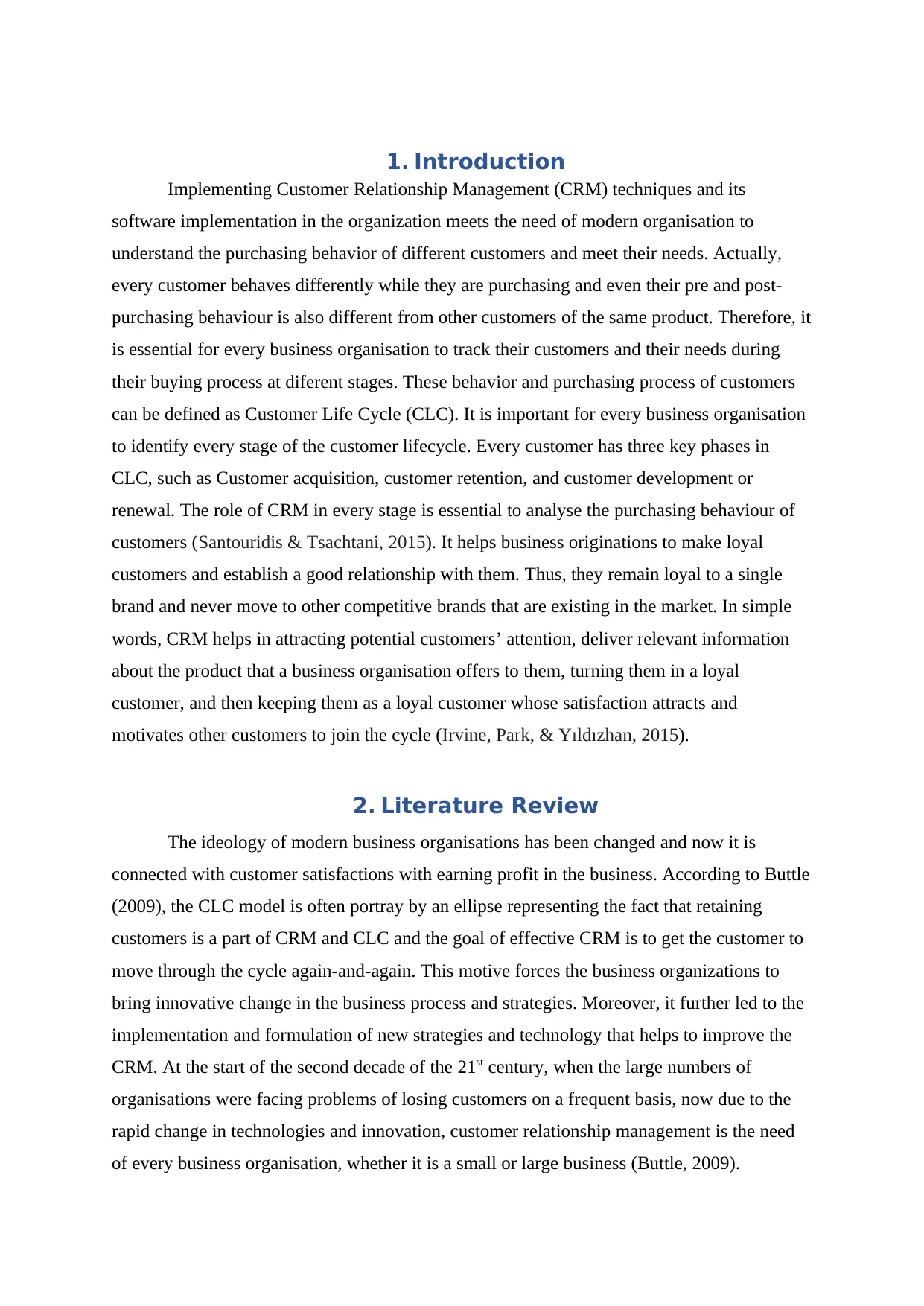
1. Introduction
Implementing Customer Relationship Management (CRM) techniques and its
software implementation in the organization meets the need of modern organisation to
understand the purchasing behavior of different customers and meet their needs. Actually,
every customer behaves differently while they are purchasing and even their pre and post-
purchasing behaviour is also different from other customers of the same product. Therefore, it
is essential for every business organisation to track their customers and their needs during
their buying process at diferent stages. These behavior and purchasing process of customers
can be defined as Customer Life Cycle (CLC). It is important for every business organisation
to identify every stage of the customer lifecycle. Every customer has three key phases in
CLC, such as Customer acquisition, customer retention, and customer development or
renewal. The role of CRM in every stage is essential to analyse the purchasing behaviour of
customers (Santouridis & Tsachtani, 2015). It helps business originations to make loyal
customers and establish a good relationship with them. Thus, they remain loyal to a single
brand and never move to other competitive brands that are existing in the market. In simple
words, CRM helps in attracting potential customers’ attention, deliver relevant information
about the product that a business organisation offers to them, turning them in a loyal
customer, and then keeping them as a loyal customer whose satisfaction attracts and
motivates other customers to join the cycle (Irvine, Park, & Yıldızhan, 2015).
2. Literature Review
The ideology of modern business organisations has been changed and now it is
connected with customer satisfactions with earning profit in the business. According to Buttle
(2009), the CLC model is often portray by an ellipse representing the fact that retaining
customers is a part of CRM and CLC and the goal of effective CRM is to get the customer to
move through the cycle again-and-again. This motive forces the business organizations to
bring innovative change in the business process and strategies. Moreover, it further led to the
implementation and formulation of new strategies and technology that helps to improve the
CRM. At the start of the second decade of the 21st century, when the large numbers of
organisations were facing problems of losing customers on a frequent basis, now due to the
rapid change in technologies and innovation, customer relationship management is the need
of every business organisation, whether it is a small or large business (Buttle, 2009).
Implementing Customer Relationship Management (CRM) techniques and its
software implementation in the organization meets the need of modern organisation to
understand the purchasing behavior of different customers and meet their needs. Actually,
every customer behaves differently while they are purchasing and even their pre and post-
purchasing behaviour is also different from other customers of the same product. Therefore, it
is essential for every business organisation to track their customers and their needs during
their buying process at diferent stages. These behavior and purchasing process of customers
can be defined as Customer Life Cycle (CLC). It is important for every business organisation
to identify every stage of the customer lifecycle. Every customer has three key phases in
CLC, such as Customer acquisition, customer retention, and customer development or
renewal. The role of CRM in every stage is essential to analyse the purchasing behaviour of
customers (Santouridis & Tsachtani, 2015). It helps business originations to make loyal
customers and establish a good relationship with them. Thus, they remain loyal to a single
brand and never move to other competitive brands that are existing in the market. In simple
words, CRM helps in attracting potential customers’ attention, deliver relevant information
about the product that a business organisation offers to them, turning them in a loyal
customer, and then keeping them as a loyal customer whose satisfaction attracts and
motivates other customers to join the cycle (Irvine, Park, & Yıldızhan, 2015).
2. Literature Review
The ideology of modern business organisations has been changed and now it is
connected with customer satisfactions with earning profit in the business. According to Buttle
(2009), the CLC model is often portray by an ellipse representing the fact that retaining
customers is a part of CRM and CLC and the goal of effective CRM is to get the customer to
move through the cycle again-and-again. This motive forces the business organizations to
bring innovative change in the business process and strategies. Moreover, it further led to the
implementation and formulation of new strategies and technology that helps to improve the
CRM. At the start of the second decade of the 21st century, when the large numbers of
organisations were facing problems of losing customers on a frequent basis, now due to the
rapid change in technologies and innovation, customer relationship management is the need
of every business organisation, whether it is a small or large business (Buttle, 2009).
Paraphrase This Document
Need a fresh take? Get an instant paraphrase of this document with our AI Paraphraser
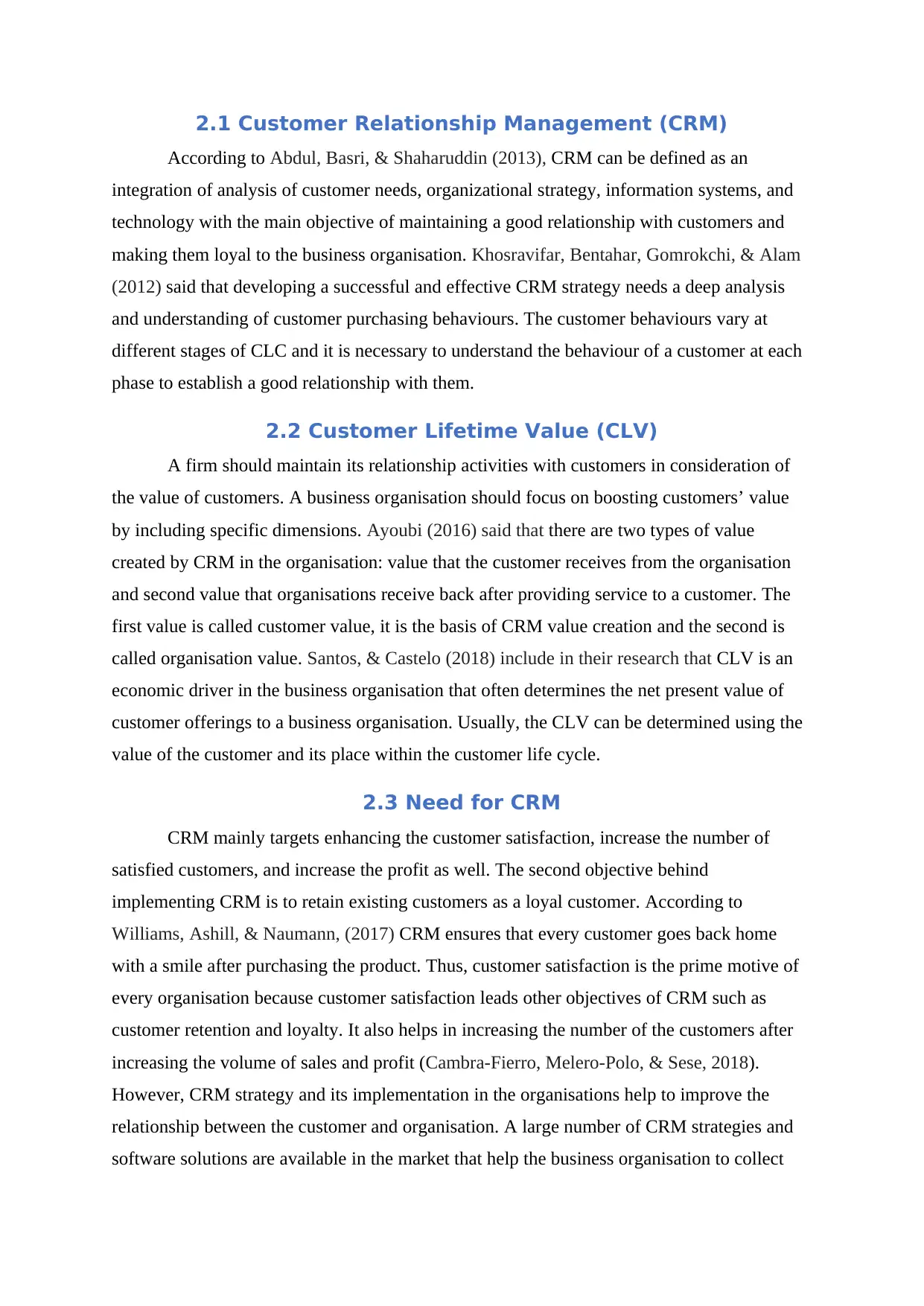
2.1 Customer Relationship Management (CRM)
According to Abdul, Basri, & Shaharuddin (2013), CRM can be defined as an
integration of analysis of customer needs, organizational strategy, information systems, and
technology with the main objective of maintaining a good relationship with customers and
making them loyal to the business organisation. Khosravifar, Bentahar, Gomrokchi, & Alam
(2012) said that developing a successful and effective CRM strategy needs a deep analysis
and understanding of customer purchasing behaviours. The customer behaviours vary at
different stages of CLC and it is necessary to understand the behaviour of a customer at each
phase to establish a good relationship with them.
2.2 Customer Lifetime Value (CLV)
A firm should maintain its relationship activities with customers in consideration of
the value of customers. A business organisation should focus on boosting customers’ value
by including specific dimensions. Ayoubi (2016) said that there are two types of value
created by CRM in the organisation: value that the customer receives from the organisation
and second value that organisations receive back after providing service to a customer. The
first value is called customer value, it is the basis of CRM value creation and the second is
called organisation value. Santos, & Castelo (2018) include in their research that CLV is an
economic driver in the business organisation that often determines the net present value of
customer offerings to a business organisation. Usually, the CLV can be determined using the
value of the customer and its place within the customer life cycle.
2.3 Need for CRM
CRM mainly targets enhancing the customer satisfaction, increase the number of
satisfied customers, and increase the profit as well. The second objective behind
implementing CRM is to retain existing customers as a loyal customer. According to
Williams, Ashill, & Naumann, (2017) CRM ensures that every customer goes back home
with a smile after purchasing the product. Thus, customer satisfaction is the prime motive of
every organisation because customer satisfaction leads other objectives of CRM such as
customer retention and loyalty. It also helps in increasing the number of the customers after
increasing the volume of sales and profit (Cambra-Fierro, Melero-Polo, & Sese, 2018).
However, CRM strategy and its implementation in the organisations help to improve the
relationship between the customer and organisation. A large number of CRM strategies and
software solutions are available in the market that help the business organisation to collect
According to Abdul, Basri, & Shaharuddin (2013), CRM can be defined as an
integration of analysis of customer needs, organizational strategy, information systems, and
technology with the main objective of maintaining a good relationship with customers and
making them loyal to the business organisation. Khosravifar, Bentahar, Gomrokchi, & Alam
(2012) said that developing a successful and effective CRM strategy needs a deep analysis
and understanding of customer purchasing behaviours. The customer behaviours vary at
different stages of CLC and it is necessary to understand the behaviour of a customer at each
phase to establish a good relationship with them.
2.2 Customer Lifetime Value (CLV)
A firm should maintain its relationship activities with customers in consideration of
the value of customers. A business organisation should focus on boosting customers’ value
by including specific dimensions. Ayoubi (2016) said that there are two types of value
created by CRM in the organisation: value that the customer receives from the organisation
and second value that organisations receive back after providing service to a customer. The
first value is called customer value, it is the basis of CRM value creation and the second is
called organisation value. Santos, & Castelo (2018) include in their research that CLV is an
economic driver in the business organisation that often determines the net present value of
customer offerings to a business organisation. Usually, the CLV can be determined using the
value of the customer and its place within the customer life cycle.
2.3 Need for CRM
CRM mainly targets enhancing the customer satisfaction, increase the number of
satisfied customers, and increase the profit as well. The second objective behind
implementing CRM is to retain existing customers as a loyal customer. According to
Williams, Ashill, & Naumann, (2017) CRM ensures that every customer goes back home
with a smile after purchasing the product. Thus, customer satisfaction is the prime motive of
every organisation because customer satisfaction leads other objectives of CRM such as
customer retention and loyalty. It also helps in increasing the number of the customers after
increasing the volume of sales and profit (Cambra-Fierro, Melero-Polo, & Sese, 2018).
However, CRM strategy and its implementation in the organisations help to improve the
relationship between the customer and organisation. A large number of CRM strategies and
software solutions are available in the market that help the business organisation to collect
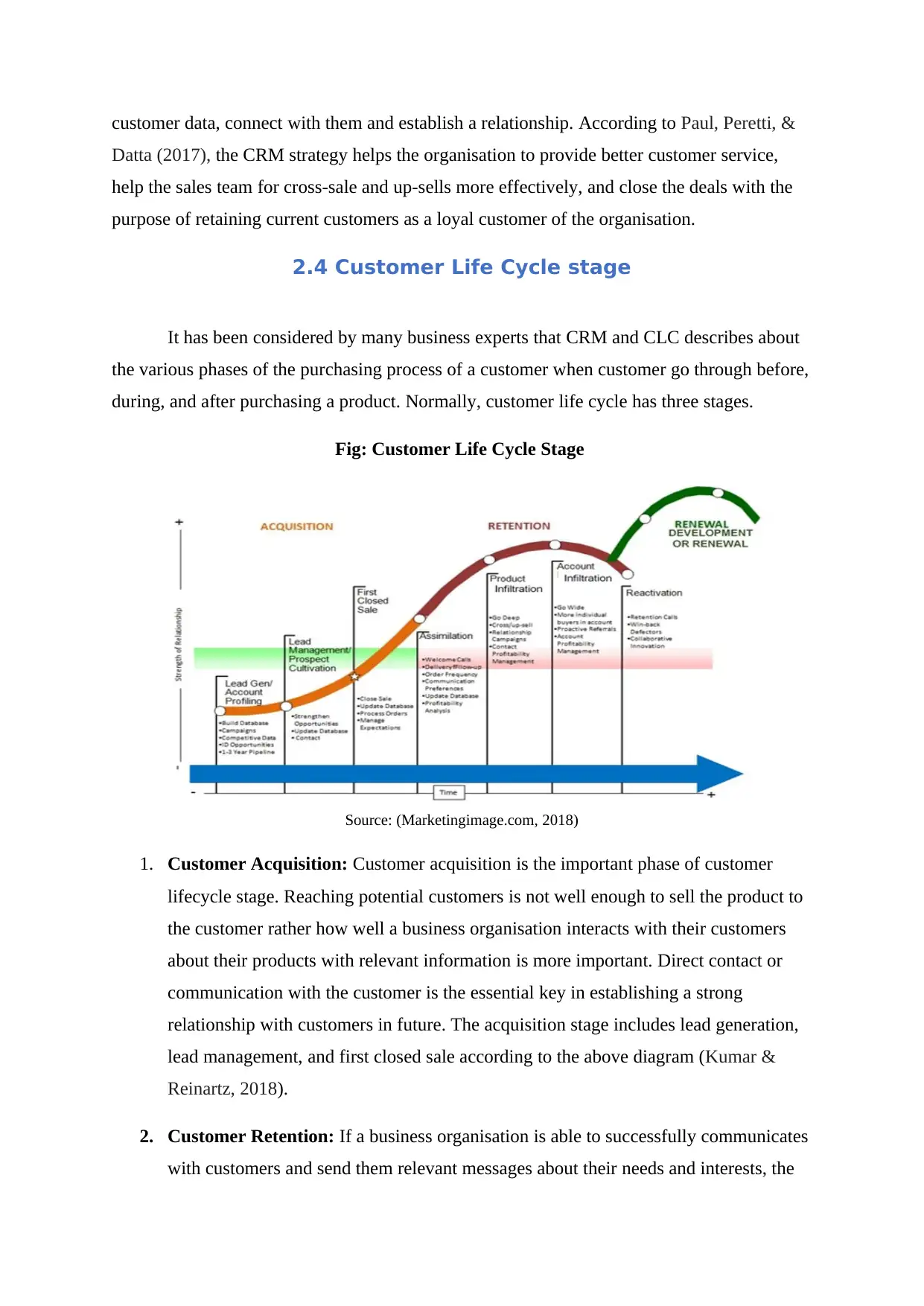
customer data, connect with them and establish a relationship. According to Paul, Peretti, &
Datta (2017), the CRM strategy helps the organisation to provide better customer service,
help the sales team for cross-sale and up-sells more effectively, and close the deals with the
purpose of retaining current customers as a loyal customer of the organisation.
2.4 Customer Life Cycle stage
It has been considered by many business experts that CRM and CLC describes about
the various phases of the purchasing process of a customer when customer go through before,
during, and after purchasing a product. Normally, customer life cycle has three stages.
Fig: Customer Life Cycle Stage
Source: (Marketingimage.com, 2018)
1. Customer Acquisition: Customer acquisition is the important phase of customer
lifecycle stage. Reaching potential customers is not well enough to sell the product to
the customer rather how well a business organisation interacts with their customers
about their products with relevant information is more important. Direct contact or
communication with the customer is the essential key in establishing a strong
relationship with customers in future. The acquisition stage includes lead generation,
lead management, and first closed sale according to the above diagram (Kumar &
Reinartz, 2018).
2. Customer Retention: If a business organisation is able to successfully communicates
with customers and send them relevant messages about their needs and interests, the
Datta (2017), the CRM strategy helps the organisation to provide better customer service,
help the sales team for cross-sale and up-sells more effectively, and close the deals with the
purpose of retaining current customers as a loyal customer of the organisation.
2.4 Customer Life Cycle stage
It has been considered by many business experts that CRM and CLC describes about
the various phases of the purchasing process of a customer when customer go through before,
during, and after purchasing a product. Normally, customer life cycle has three stages.
Fig: Customer Life Cycle Stage
Source: (Marketingimage.com, 2018)
1. Customer Acquisition: Customer acquisition is the important phase of customer
lifecycle stage. Reaching potential customers is not well enough to sell the product to
the customer rather how well a business organisation interacts with their customers
about their products with relevant information is more important. Direct contact or
communication with the customer is the essential key in establishing a strong
relationship with customers in future. The acquisition stage includes lead generation,
lead management, and first closed sale according to the above diagram (Kumar &
Reinartz, 2018).
2. Customer Retention: If a business organisation is able to successfully communicates
with customers and send them relevant messages about their needs and interests, the
⊘ This is a preview!⊘
Do you want full access?
Subscribe today to unlock all pages.

Trusted by 1+ million students worldwide
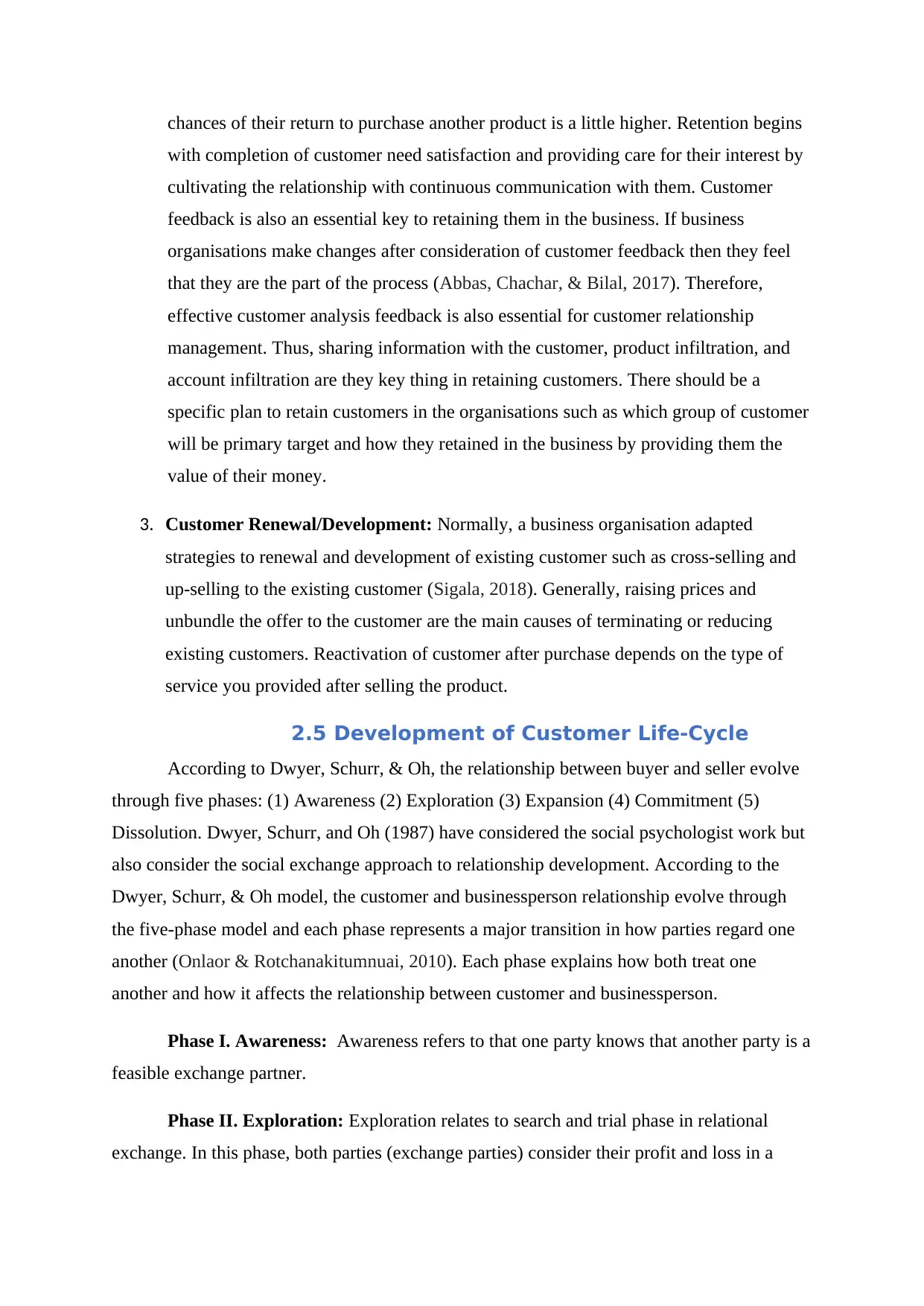
chances of their return to purchase another product is a little higher. Retention begins
with completion of customer need satisfaction and providing care for their interest by
cultivating the relationship with continuous communication with them. Customer
feedback is also an essential key to retaining them in the business. If business
organisations make changes after consideration of customer feedback then they feel
that they are the part of the process (Abbas, Chachar, & Bilal, 2017). Therefore,
effective customer analysis feedback is also essential for customer relationship
management. Thus, sharing information with the customer, product infiltration, and
account infiltration are they key thing in retaining customers. There should be a
specific plan to retain customers in the organisations such as which group of customer
will be primary target and how they retained in the business by providing them the
value of their money.
3. Customer Renewal/Development: Normally, a business organisation adapted
strategies to renewal and development of existing customer such as cross-selling and
up-selling to the existing customer (Sigala, 2018). Generally, raising prices and
unbundle the offer to the customer are the main causes of terminating or reducing
existing customers. Reactivation of customer after purchase depends on the type of
service you provided after selling the product.
2.5 Development of Customer Life-Cycle
According to Dwyer, Schurr, & Oh, the relationship between buyer and seller evolve
through five phases: (1) Awareness (2) Exploration (3) Expansion (4) Commitment (5)
Dissolution. Dwyer, Schurr, and Oh (1987) have considered the social psychologist work but
also consider the social exchange approach to relationship development. According to the
Dwyer, Schurr, & Oh model, the customer and businessperson relationship evolve through
the five-phase model and each phase represents a major transition in how parties regard one
another (Onlaor & Rotchanakitumnuai, 2010). Each phase explains how both treat one
another and how it affects the relationship between customer and businessperson.
Phase I. Awareness: Awareness refers to that one party knows that another party is a
feasible exchange partner.
Phase II. Exploration: Exploration relates to search and trial phase in relational
exchange. In this phase, both parties (exchange parties) consider their profit and loss in a
with completion of customer need satisfaction and providing care for their interest by
cultivating the relationship with continuous communication with them. Customer
feedback is also an essential key to retaining them in the business. If business
organisations make changes after consideration of customer feedback then they feel
that they are the part of the process (Abbas, Chachar, & Bilal, 2017). Therefore,
effective customer analysis feedback is also essential for customer relationship
management. Thus, sharing information with the customer, product infiltration, and
account infiltration are they key thing in retaining customers. There should be a
specific plan to retain customers in the organisations such as which group of customer
will be primary target and how they retained in the business by providing them the
value of their money.
3. Customer Renewal/Development: Normally, a business organisation adapted
strategies to renewal and development of existing customer such as cross-selling and
up-selling to the existing customer (Sigala, 2018). Generally, raising prices and
unbundle the offer to the customer are the main causes of terminating or reducing
existing customers. Reactivation of customer after purchase depends on the type of
service you provided after selling the product.
2.5 Development of Customer Life-Cycle
According to Dwyer, Schurr, & Oh, the relationship between buyer and seller evolve
through five phases: (1) Awareness (2) Exploration (3) Expansion (4) Commitment (5)
Dissolution. Dwyer, Schurr, and Oh (1987) have considered the social psychologist work but
also consider the social exchange approach to relationship development. According to the
Dwyer, Schurr, & Oh model, the customer and businessperson relationship evolve through
the five-phase model and each phase represents a major transition in how parties regard one
another (Onlaor & Rotchanakitumnuai, 2010). Each phase explains how both treat one
another and how it affects the relationship between customer and businessperson.
Phase I. Awareness: Awareness refers to that one party knows that another party is a
feasible exchange partner.
Phase II. Exploration: Exploration relates to search and trial phase in relational
exchange. In this phase, both parties (exchange parties) consider their profit and loss in a
Paraphrase This Document
Need a fresh take? Get an instant paraphrase of this document with our AI Paraphraser
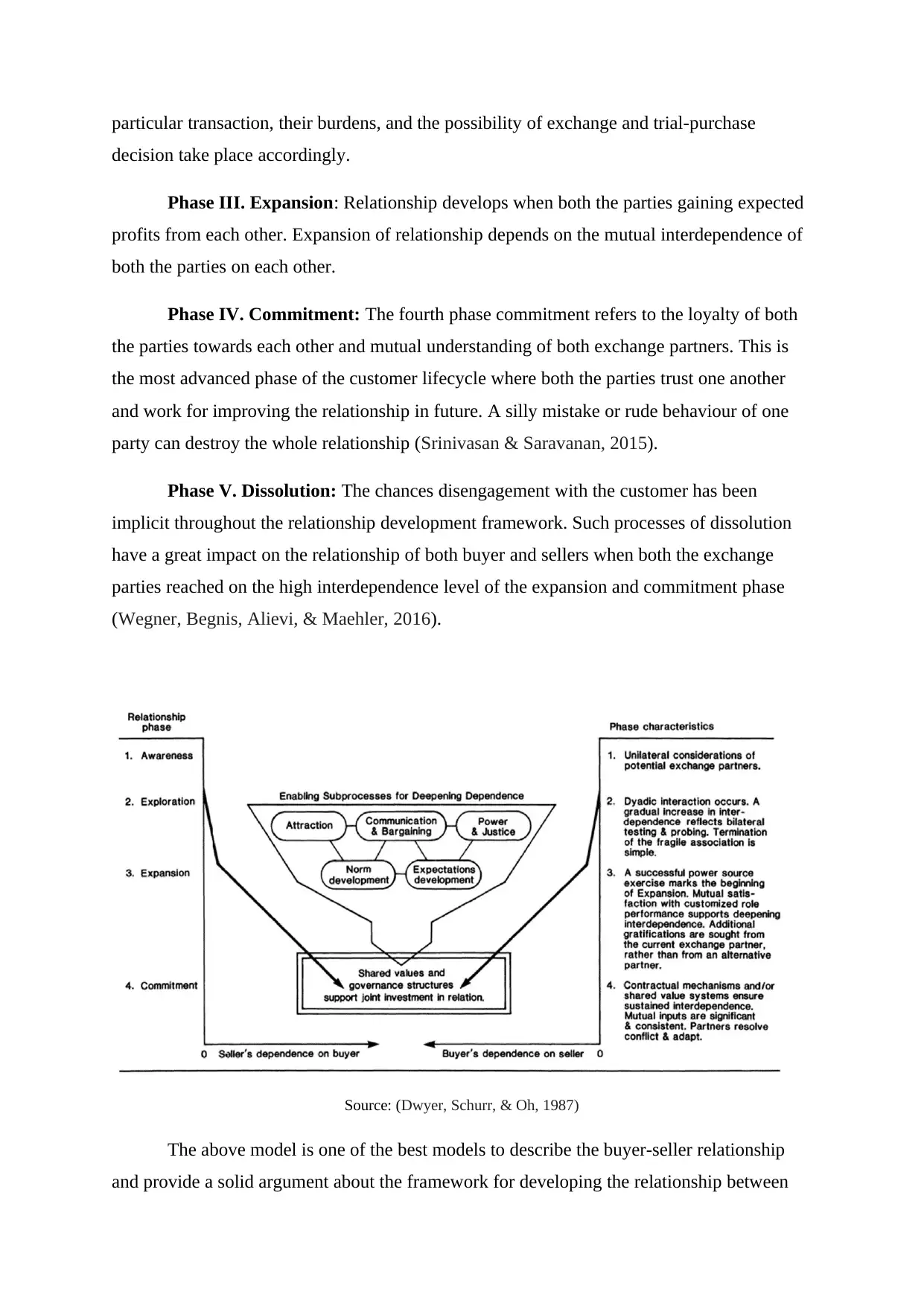
particular transaction, their burdens, and the possibility of exchange and trial-purchase
decision take place accordingly.
Phase III. Expansion: Relationship develops when both the parties gaining expected
profits from each other. Expansion of relationship depends on the mutual interdependence of
both the parties on each other.
Phase IV. Commitment: The fourth phase commitment refers to the loyalty of both
the parties towards each other and mutual understanding of both exchange partners. This is
the most advanced phase of the customer lifecycle where both the parties trust one another
and work for improving the relationship in future. A silly mistake or rude behaviour of one
party can destroy the whole relationship (Srinivasan & Saravanan, 2015).
Phase V. Dissolution: The chances disengagement with the customer has been
implicit throughout the relationship development framework. Such processes of dissolution
have a great impact on the relationship of both buyer and sellers when both the exchange
parties reached on the high interdependence level of the expansion and commitment phase
(Wegner, Begnis, Alievi, & Maehler, 2016).
Source: (Dwyer, Schurr, & Oh, 1987)
The above model is one of the best models to describe the buyer-seller relationship
and provide a solid argument about the framework for developing the relationship between
decision take place accordingly.
Phase III. Expansion: Relationship develops when both the parties gaining expected
profits from each other. Expansion of relationship depends on the mutual interdependence of
both the parties on each other.
Phase IV. Commitment: The fourth phase commitment refers to the loyalty of both
the parties towards each other and mutual understanding of both exchange partners. This is
the most advanced phase of the customer lifecycle where both the parties trust one another
and work for improving the relationship in future. A silly mistake or rude behaviour of one
party can destroy the whole relationship (Srinivasan & Saravanan, 2015).
Phase V. Dissolution: The chances disengagement with the customer has been
implicit throughout the relationship development framework. Such processes of dissolution
have a great impact on the relationship of both buyer and sellers when both the exchange
parties reached on the high interdependence level of the expansion and commitment phase
(Wegner, Begnis, Alievi, & Maehler, 2016).
Source: (Dwyer, Schurr, & Oh, 1987)
The above model is one of the best models to describe the buyer-seller relationship
and provide a solid argument about the framework for developing the relationship between
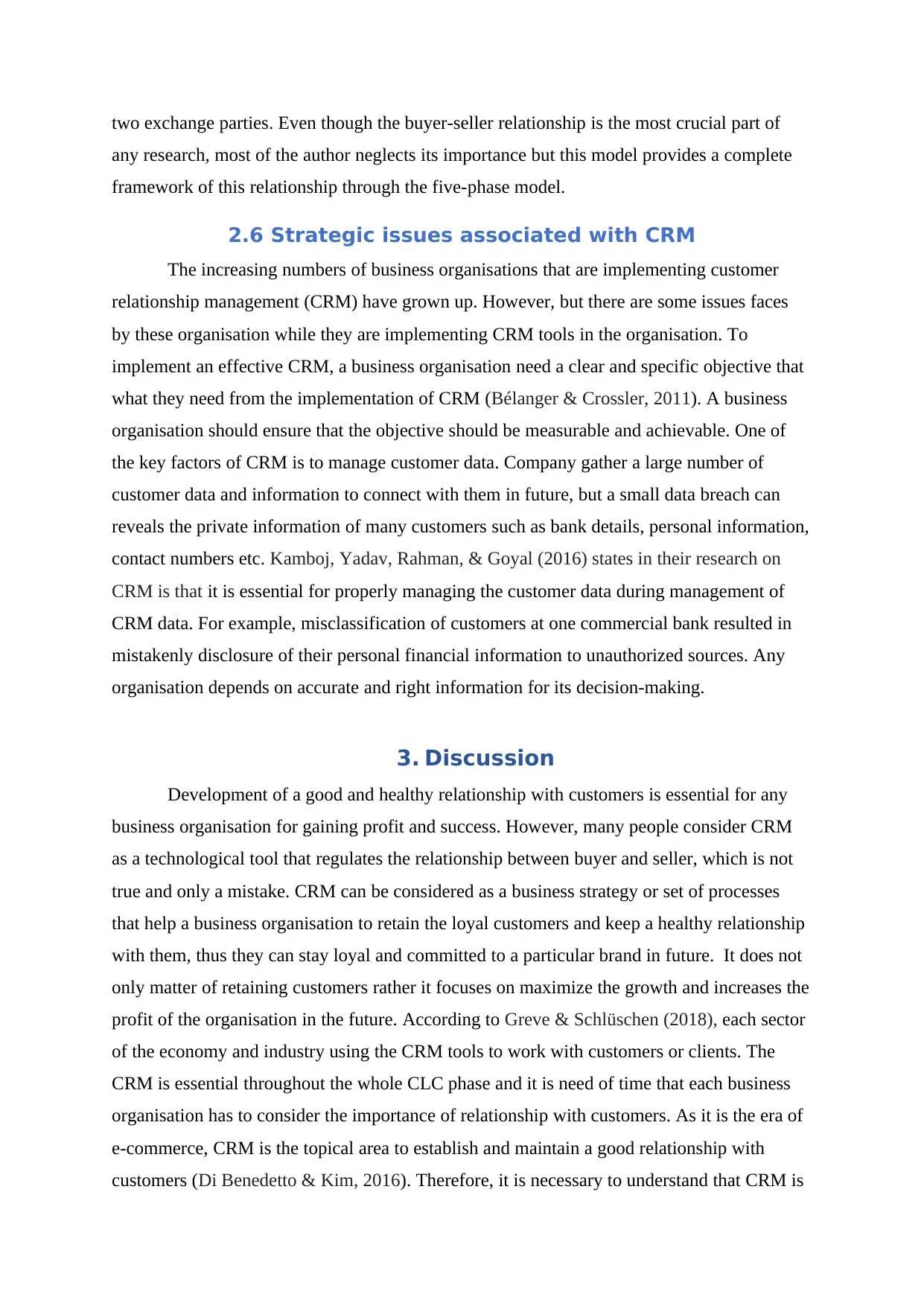
two exchange parties. Even though the buyer-seller relationship is the most crucial part of
any research, most of the author neglects its importance but this model provides a complete
framework of this relationship through the five-phase model.
2.6 Strategic issues associated with CRM
The increasing numbers of business organisations that are implementing customer
relationship management (CRM) have grown up. However, but there are some issues faces
by these organisation while they are implementing CRM tools in the organisation. To
implement an effective CRM, a business organisation need a clear and specific objective that
what they need from the implementation of CRM (Bélanger & Crossler, 2011). A business
organisation should ensure that the objective should be measurable and achievable. One of
the key factors of CRM is to manage customer data. Company gather a large number of
customer data and information to connect with them in future, but a small data breach can
reveals the private information of many customers such as bank details, personal information,
contact numbers etc. Kamboj, Yadav, Rahman, & Goyal (2016) states in their research on
CRM is that it is essential for properly managing the customer data during management of
CRM data. For example, misclassification of customers at one commercial bank resulted in
mistakenly disclosure of their personal financial information to unauthorized sources. Any
organisation depends on accurate and right information for its decision-making.
3. Discussion
Development of a good and healthy relationship with customers is essential for any
business organisation for gaining profit and success. However, many people consider CRM
as a technological tool that regulates the relationship between buyer and seller, which is not
true and only a mistake. CRM can be considered as a business strategy or set of processes
that help a business organisation to retain the loyal customers and keep a healthy relationship
with them, thus they can stay loyal and committed to a particular brand in future. It does not
only matter of retaining customers rather it focuses on maximize the growth and increases the
profit of the organisation in the future. According to Greve & Schlüschen (2018), each sector
of the economy and industry using the CRM tools to work with customers or clients. The
CRM is essential throughout the whole CLC phase and it is need of time that each business
organisation has to consider the importance of relationship with customers. As it is the era of
e-commerce, CRM is the topical area to establish and maintain a good relationship with
customers (Di Benedetto & Kim, 2016). Therefore, it is necessary to understand that CRM is
any research, most of the author neglects its importance but this model provides a complete
framework of this relationship through the five-phase model.
2.6 Strategic issues associated with CRM
The increasing numbers of business organisations that are implementing customer
relationship management (CRM) have grown up. However, but there are some issues faces
by these organisation while they are implementing CRM tools in the organisation. To
implement an effective CRM, a business organisation need a clear and specific objective that
what they need from the implementation of CRM (Bélanger & Crossler, 2011). A business
organisation should ensure that the objective should be measurable and achievable. One of
the key factors of CRM is to manage customer data. Company gather a large number of
customer data and information to connect with them in future, but a small data breach can
reveals the private information of many customers such as bank details, personal information,
contact numbers etc. Kamboj, Yadav, Rahman, & Goyal (2016) states in their research on
CRM is that it is essential for properly managing the customer data during management of
CRM data. For example, misclassification of customers at one commercial bank resulted in
mistakenly disclosure of their personal financial information to unauthorized sources. Any
organisation depends on accurate and right information for its decision-making.
3. Discussion
Development of a good and healthy relationship with customers is essential for any
business organisation for gaining profit and success. However, many people consider CRM
as a technological tool that regulates the relationship between buyer and seller, which is not
true and only a mistake. CRM can be considered as a business strategy or set of processes
that help a business organisation to retain the loyal customers and keep a healthy relationship
with them, thus they can stay loyal and committed to a particular brand in future. It does not
only matter of retaining customers rather it focuses on maximize the growth and increases the
profit of the organisation in the future. According to Greve & Schlüschen (2018), each sector
of the economy and industry using the CRM tools to work with customers or clients. The
CRM is essential throughout the whole CLC phase and it is need of time that each business
organisation has to consider the importance of relationship with customers. As it is the era of
e-commerce, CRM is the topical area to establish and maintain a good relationship with
customers (Di Benedetto & Kim, 2016). Therefore, it is necessary to understand that CRM is
⊘ This is a preview!⊘
Do you want full access?
Subscribe today to unlock all pages.

Trusted by 1+ million students worldwide
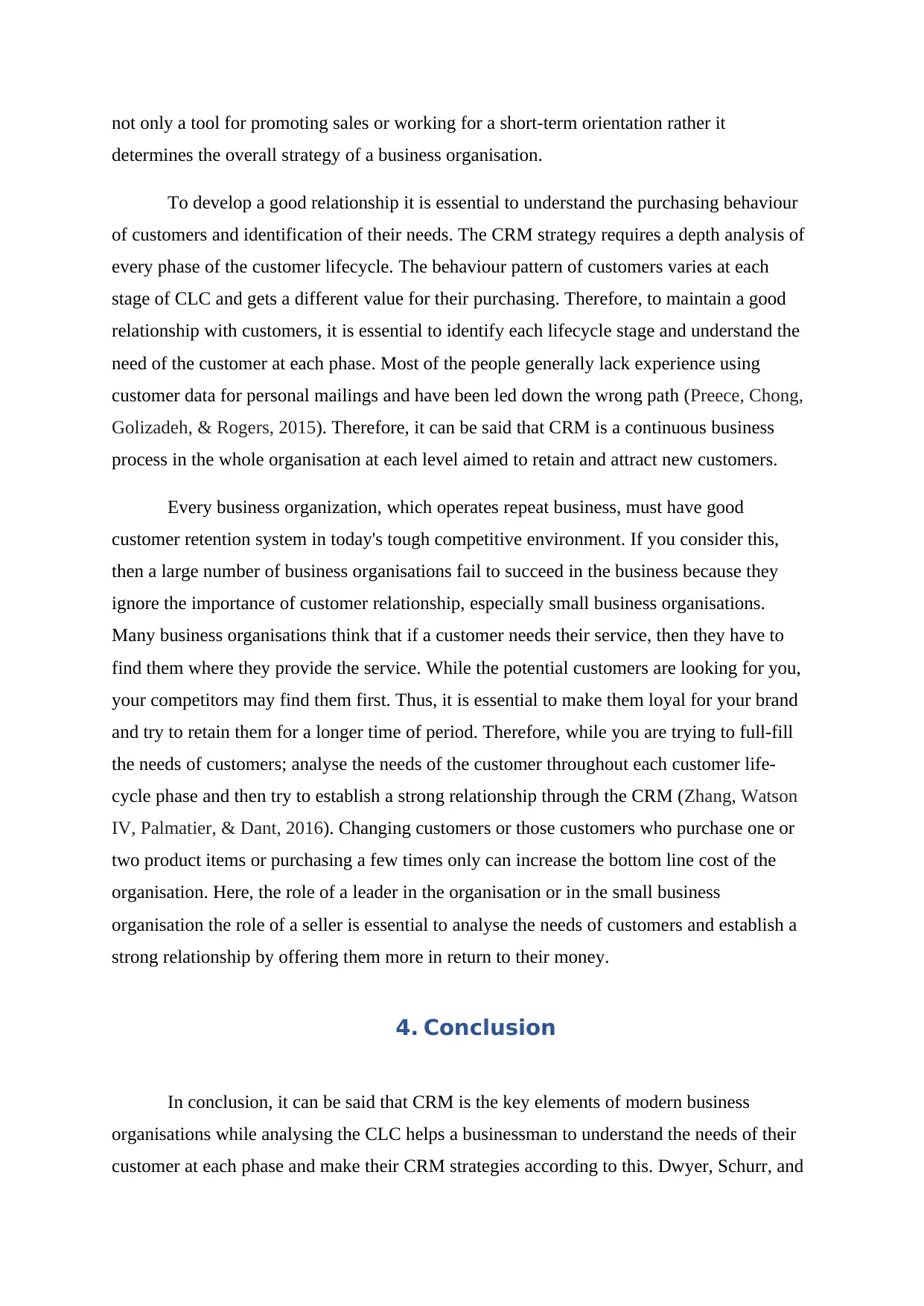
not only a tool for promoting sales or working for a short-term orientation rather it
determines the overall strategy of a business organisation.
To develop a good relationship it is essential to understand the purchasing behaviour
of customers and identification of their needs. The CRM strategy requires a depth analysis of
every phase of the customer lifecycle. The behaviour pattern of customers varies at each
stage of CLC and gets a different value for their purchasing. Therefore, to maintain a good
relationship with customers, it is essential to identify each lifecycle stage and understand the
need of the customer at each phase. Most of the people generally lack experience using
customer data for personal mailings and have been led down the wrong path (Preece, Chong,
Golizadeh, & Rogers, 2015). Therefore, it can be said that CRM is a continuous business
process in the whole organisation at each level aimed to retain and attract new customers.
Every business organization, which operates repeat business, must have good
customer retention system in today's tough competitive environment. If you consider this,
then a large number of business organisations fail to succeed in the business because they
ignore the importance of customer relationship, especially small business organisations.
Many business organisations think that if a customer needs their service, then they have to
find them where they provide the service. While the potential customers are looking for you,
your competitors may find them first. Thus, it is essential to make them loyal for your brand
and try to retain them for a longer time of period. Therefore, while you are trying to full-fill
the needs of customers; analyse the needs of the customer throughout each customer life-
cycle phase and then try to establish a strong relationship through the CRM (Zhang, Watson
IV, Palmatier, & Dant, 2016). Changing customers or those customers who purchase one or
two product items or purchasing a few times only can increase the bottom line cost of the
organisation. Here, the role of a leader in the organisation or in the small business
organisation the role of a seller is essential to analyse the needs of customers and establish a
strong relationship by offering them more in return to their money.
4. Conclusion
In conclusion, it can be said that CRM is the key elements of modern business
organisations while analysing the CLC helps a businessman to understand the needs of their
customer at each phase and make their CRM strategies according to this. Dwyer, Schurr, and
determines the overall strategy of a business organisation.
To develop a good relationship it is essential to understand the purchasing behaviour
of customers and identification of their needs. The CRM strategy requires a depth analysis of
every phase of the customer lifecycle. The behaviour pattern of customers varies at each
stage of CLC and gets a different value for their purchasing. Therefore, to maintain a good
relationship with customers, it is essential to identify each lifecycle stage and understand the
need of the customer at each phase. Most of the people generally lack experience using
customer data for personal mailings and have been led down the wrong path (Preece, Chong,
Golizadeh, & Rogers, 2015). Therefore, it can be said that CRM is a continuous business
process in the whole organisation at each level aimed to retain and attract new customers.
Every business organization, which operates repeat business, must have good
customer retention system in today's tough competitive environment. If you consider this,
then a large number of business organisations fail to succeed in the business because they
ignore the importance of customer relationship, especially small business organisations.
Many business organisations think that if a customer needs their service, then they have to
find them where they provide the service. While the potential customers are looking for you,
your competitors may find them first. Thus, it is essential to make them loyal for your brand
and try to retain them for a longer time of period. Therefore, while you are trying to full-fill
the needs of customers; analyse the needs of the customer throughout each customer life-
cycle phase and then try to establish a strong relationship through the CRM (Zhang, Watson
IV, Palmatier, & Dant, 2016). Changing customers or those customers who purchase one or
two product items or purchasing a few times only can increase the bottom line cost of the
organisation. Here, the role of a leader in the organisation or in the small business
organisation the role of a seller is essential to analyse the needs of customers and establish a
strong relationship by offering them more in return to their money.
4. Conclusion
In conclusion, it can be said that CRM is the key elements of modern business
organisations while analysing the CLC helps a businessman to understand the needs of their
customer at each phase and make their CRM strategies according to this. Dwyer, Schurr, and
Paraphrase This Document
Need a fresh take? Get an instant paraphrase of this document with our AI Paraphraser
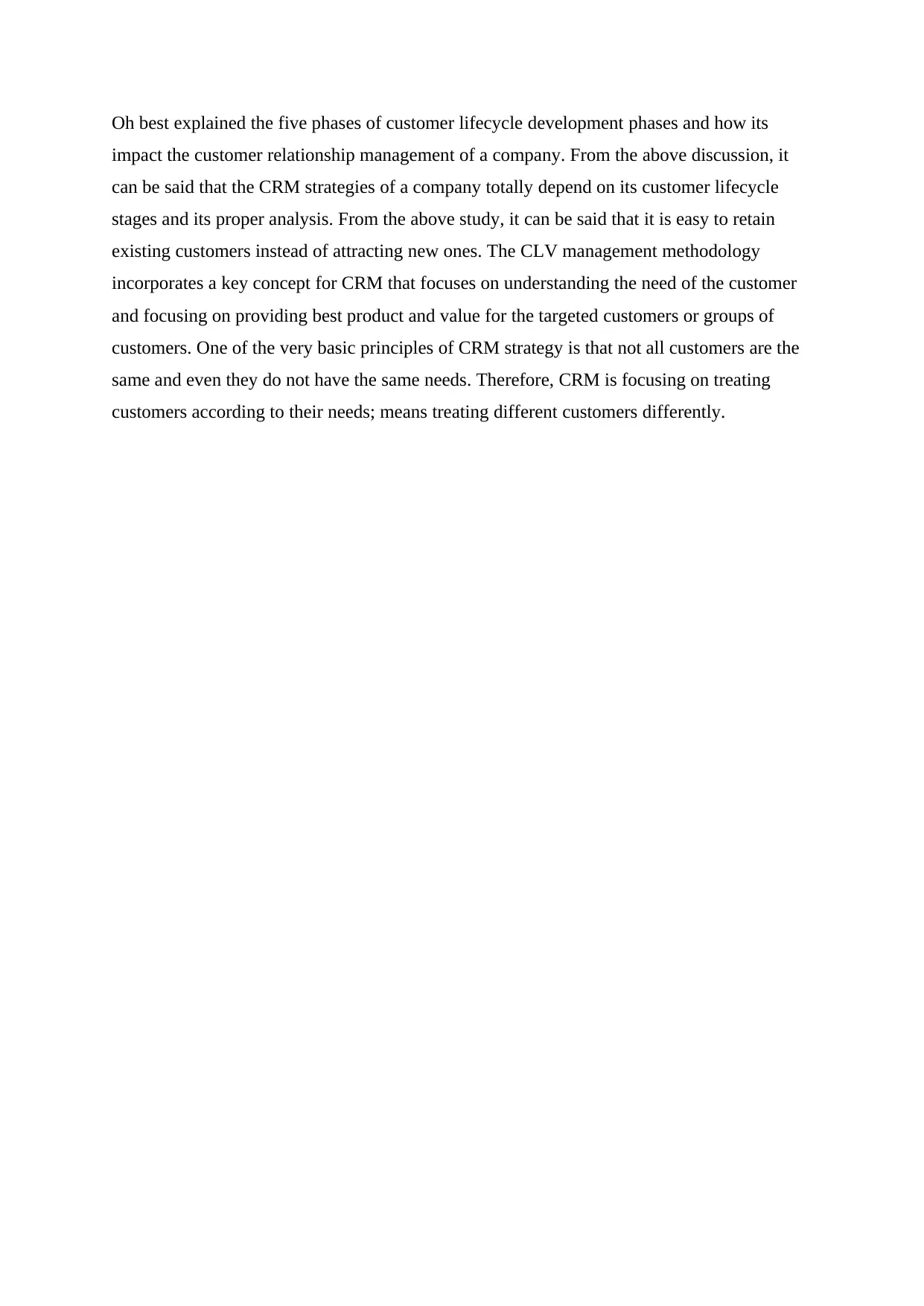
Oh best explained the five phases of customer lifecycle development phases and how its
impact the customer relationship management of a company. From the above discussion, it
can be said that the CRM strategies of a company totally depend on its customer lifecycle
stages and its proper analysis. From the above study, it can be said that it is easy to retain
existing customers instead of attracting new ones. The CLV management methodology
incorporates a key concept for CRM that focuses on understanding the need of the customer
and focusing on providing best product and value for the targeted customers or groups of
customers. One of the very basic principles of CRM strategy is that not all customers are the
same and even they do not have the same needs. Therefore, CRM is focusing on treating
customers according to their needs; means treating different customers differently.
impact the customer relationship management of a company. From the above discussion, it
can be said that the CRM strategies of a company totally depend on its customer lifecycle
stages and its proper analysis. From the above study, it can be said that it is easy to retain
existing customers instead of attracting new ones. The CLV management methodology
incorporates a key concept for CRM that focuses on understanding the need of the customer
and focusing on providing best product and value for the targeted customers or groups of
customers. One of the very basic principles of CRM strategy is that not all customers are the
same and even they do not have the same needs. Therefore, CRM is focusing on treating
customers according to their needs; means treating different customers differently.
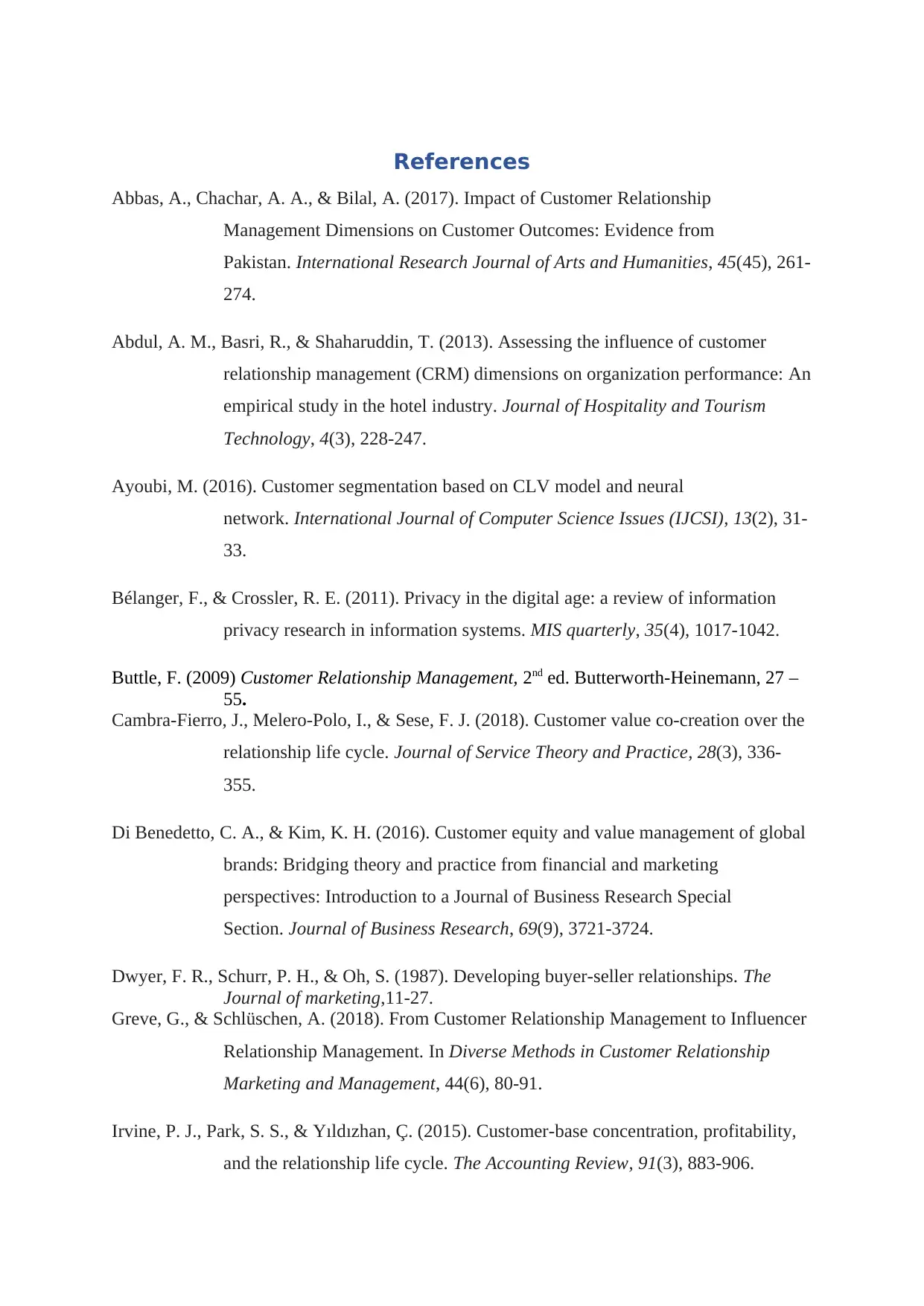
References
Abbas, A., Chachar, A. A., & Bilal, A. (2017). Impact of Customer Relationship
Management Dimensions on Customer Outcomes: Evidence from
Pakistan. International Research Journal of Arts and Humanities, 45(45), 261-
274.
Abdul, A. M., Basri, R., & Shaharuddin, T. (2013). Assessing the influence of customer
relationship management (CRM) dimensions on organization performance: An
empirical study in the hotel industry. Journal of Hospitality and Tourism
Technology, 4(3), 228-247.
Ayoubi, M. (2016). Customer segmentation based on CLV model and neural
network. International Journal of Computer Science Issues (IJCSI), 13(2), 31-
33.
Bélanger, F., & Crossler, R. E. (2011). Privacy in the digital age: a review of information
privacy research in information systems. MIS quarterly, 35(4), 1017-1042.
Buttle, F. (2009) Customer Relationship Management, 2nd ed. Butterworth-Heinemann, 27 –
55.
Cambra-Fierro, J., Melero-Polo, I., & Sese, F. J. (2018). Customer value co-creation over the
relationship life cycle. Journal of Service Theory and Practice, 28(3), 336-
355.
Di Benedetto, C. A., & Kim, K. H. (2016). Customer equity and value management of global
brands: Bridging theory and practice from financial and marketing
perspectives: Introduction to a Journal of Business Research Special
Section. Journal of Business Research, 69(9), 3721-3724.
Dwyer, F. R., Schurr, P. H., & Oh, S. (1987). Developing buyer-seller relationships. The
Journal of marketing,11-27.
Greve, G., & Schlüschen, A. (2018). From Customer Relationship Management to Influencer
Relationship Management. In Diverse Methods in Customer Relationship
Marketing and Management, 44(6), 80-91.
Irvine, P. J., Park, S. S., & Yıldızhan, Ç. (2015). Customer-base concentration, profitability,
and the relationship life cycle. The Accounting Review, 91(3), 883-906.
Abbas, A., Chachar, A. A., & Bilal, A. (2017). Impact of Customer Relationship
Management Dimensions on Customer Outcomes: Evidence from
Pakistan. International Research Journal of Arts and Humanities, 45(45), 261-
274.
Abdul, A. M., Basri, R., & Shaharuddin, T. (2013). Assessing the influence of customer
relationship management (CRM) dimensions on organization performance: An
empirical study in the hotel industry. Journal of Hospitality and Tourism
Technology, 4(3), 228-247.
Ayoubi, M. (2016). Customer segmentation based on CLV model and neural
network. International Journal of Computer Science Issues (IJCSI), 13(2), 31-
33.
Bélanger, F., & Crossler, R. E. (2011). Privacy in the digital age: a review of information
privacy research in information systems. MIS quarterly, 35(4), 1017-1042.
Buttle, F. (2009) Customer Relationship Management, 2nd ed. Butterworth-Heinemann, 27 –
55.
Cambra-Fierro, J., Melero-Polo, I., & Sese, F. J. (2018). Customer value co-creation over the
relationship life cycle. Journal of Service Theory and Practice, 28(3), 336-
355.
Di Benedetto, C. A., & Kim, K. H. (2016). Customer equity and value management of global
brands: Bridging theory and practice from financial and marketing
perspectives: Introduction to a Journal of Business Research Special
Section. Journal of Business Research, 69(9), 3721-3724.
Dwyer, F. R., Schurr, P. H., & Oh, S. (1987). Developing buyer-seller relationships. The
Journal of marketing,11-27.
Greve, G., & Schlüschen, A. (2018). From Customer Relationship Management to Influencer
Relationship Management. In Diverse Methods in Customer Relationship
Marketing and Management, 44(6), 80-91.
Irvine, P. J., Park, S. S., & Yıldızhan, Ç. (2015). Customer-base concentration, profitability,
and the relationship life cycle. The Accounting Review, 91(3), 883-906.
⊘ This is a preview!⊘
Do you want full access?
Subscribe today to unlock all pages.

Trusted by 1+ million students worldwide
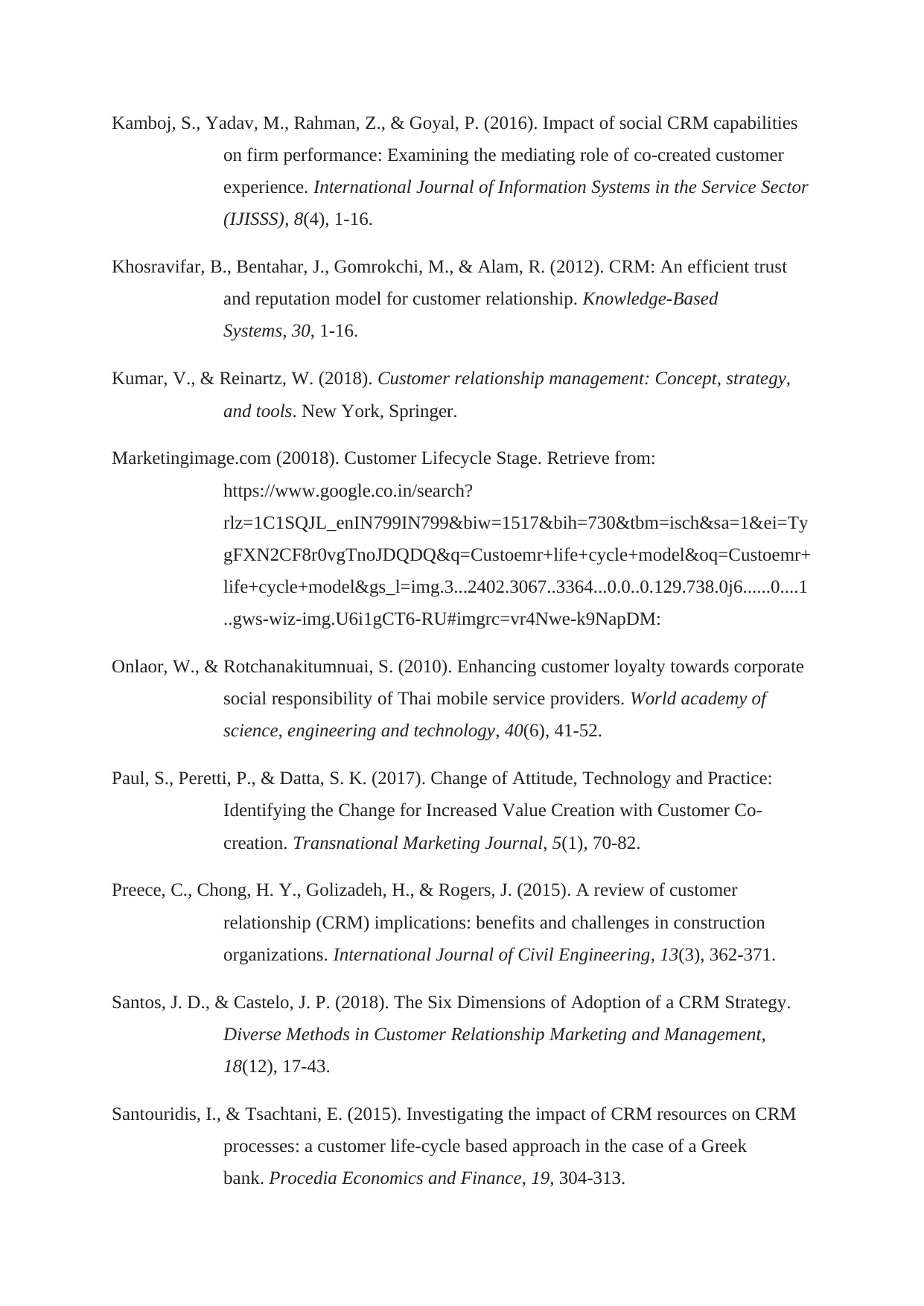
Kamboj, S., Yadav, M., Rahman, Z., & Goyal, P. (2016). Impact of social CRM capabilities
on firm performance: Examining the mediating role of co-created customer
experience. International Journal of Information Systems in the Service Sector
(IJISSS), 8(4), 1-16.
Khosravifar, B., Bentahar, J., Gomrokchi, M., & Alam, R. (2012). CRM: An efficient trust
and reputation model for customer relationship. Knowledge-Based
Systems, 30, 1-16.
Kumar, V., & Reinartz, W. (2018). Customer relationship management: Concept, strategy,
and tools. New York, Springer.
Marketingimage.com (20018). Customer Lifecycle Stage. Retrieve from:
https://www.google.co.in/search?
rlz=1C1SQJL_enIN799IN799&biw=1517&bih=730&tbm=isch&sa=1&ei=Ty
gFXN2CF8r0vgTnoJDQDQ&q=Custoemr+life+cycle+model&oq=Custoemr+
life+cycle+model&gs_l=img.3...2402.3067..3364...0.0..0.129.738.0j6......0....1
..gws-wiz-img.U6i1gCT6-RU#imgrc=vr4Nwe-k9NapDM:
Onlaor, W., & Rotchanakitumnuai, S. (2010). Enhancing customer loyalty towards corporate
social responsibility of Thai mobile service providers. World academy of
science, engineering and technology, 40(6), 41-52.
Paul, S., Peretti, P., & Datta, S. K. (2017). Change of Attitude, Technology and Practice:
Identifying the Change for Increased Value Creation with Customer Co-
creation. Transnational Marketing Journal, 5(1), 70-82.
Preece, C., Chong, H. Y., Golizadeh, H., & Rogers, J. (2015). A review of customer
relationship (CRM) implications: benefits and challenges in construction
organizations. International Journal of Civil Engineering, 13(3), 362-371.
Santos, J. D., & Castelo, J. P. (2018). The Six Dimensions of Adoption of a CRM Strategy.
Diverse Methods in Customer Relationship Marketing and Management,
18(12), 17-43.
Santouridis, I., & Tsachtani, E. (2015). Investigating the impact of CRM resources on CRM
processes: a customer life-cycle based approach in the case of a Greek
bank. Procedia Economics and Finance, 19, 304-313.
on firm performance: Examining the mediating role of co-created customer
experience. International Journal of Information Systems in the Service Sector
(IJISSS), 8(4), 1-16.
Khosravifar, B., Bentahar, J., Gomrokchi, M., & Alam, R. (2012). CRM: An efficient trust
and reputation model for customer relationship. Knowledge-Based
Systems, 30, 1-16.
Kumar, V., & Reinartz, W. (2018). Customer relationship management: Concept, strategy,
and tools. New York, Springer.
Marketingimage.com (20018). Customer Lifecycle Stage. Retrieve from:
https://www.google.co.in/search?
rlz=1C1SQJL_enIN799IN799&biw=1517&bih=730&tbm=isch&sa=1&ei=Ty
gFXN2CF8r0vgTnoJDQDQ&q=Custoemr+life+cycle+model&oq=Custoemr+
life+cycle+model&gs_l=img.3...2402.3067..3364...0.0..0.129.738.0j6......0....1
..gws-wiz-img.U6i1gCT6-RU#imgrc=vr4Nwe-k9NapDM:
Onlaor, W., & Rotchanakitumnuai, S. (2010). Enhancing customer loyalty towards corporate
social responsibility of Thai mobile service providers. World academy of
science, engineering and technology, 40(6), 41-52.
Paul, S., Peretti, P., & Datta, S. K. (2017). Change of Attitude, Technology and Practice:
Identifying the Change for Increased Value Creation with Customer Co-
creation. Transnational Marketing Journal, 5(1), 70-82.
Preece, C., Chong, H. Y., Golizadeh, H., & Rogers, J. (2015). A review of customer
relationship (CRM) implications: benefits and challenges in construction
organizations. International Journal of Civil Engineering, 13(3), 362-371.
Santos, J. D., & Castelo, J. P. (2018). The Six Dimensions of Adoption of a CRM Strategy.
Diverse Methods in Customer Relationship Marketing and Management,
18(12), 17-43.
Santouridis, I., & Tsachtani, E. (2015). Investigating the impact of CRM resources on CRM
processes: a customer life-cycle based approach in the case of a Greek
bank. Procedia Economics and Finance, 19, 304-313.
Paraphrase This Document
Need a fresh take? Get an instant paraphrase of this document with our AI Paraphraser
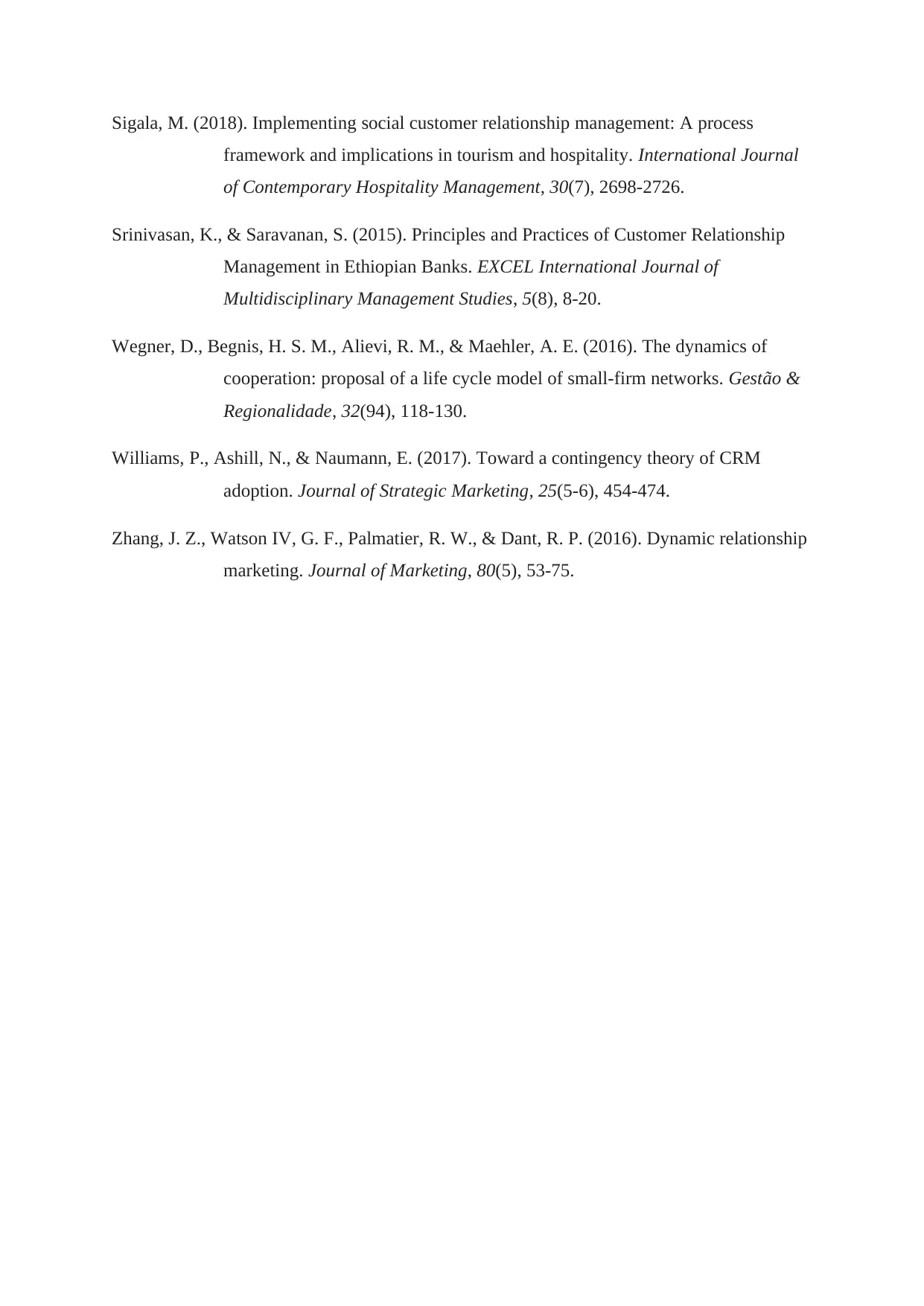
Sigala, M. (2018). Implementing social customer relationship management: A process
framework and implications in tourism and hospitality. International Journal
of Contemporary Hospitality Management, 30(7), 2698-2726.
Srinivasan, K., & Saravanan, S. (2015). Principles and Practices of Customer Relationship
Management in Ethiopian Banks. EXCEL International Journal of
Multidisciplinary Management Studies, 5(8), 8-20.
Wegner, D., Begnis, H. S. M., Alievi, R. M., & Maehler, A. E. (2016). The dynamics of
cooperation: proposal of a life cycle model of small-firm networks. Gestão &
Regionalidade, 32(94), 118-130.
Williams, P., Ashill, N., & Naumann, E. (2017). Toward a contingency theory of CRM
adoption. Journal of Strategic Marketing, 25(5-6), 454-474.
Zhang, J. Z., Watson IV, G. F., Palmatier, R. W., & Dant, R. P. (2016). Dynamic relationship
marketing. Journal of Marketing, 80(5), 53-75.
framework and implications in tourism and hospitality. International Journal
of Contemporary Hospitality Management, 30(7), 2698-2726.
Srinivasan, K., & Saravanan, S. (2015). Principles and Practices of Customer Relationship
Management in Ethiopian Banks. EXCEL International Journal of
Multidisciplinary Management Studies, 5(8), 8-20.
Wegner, D., Begnis, H. S. M., Alievi, R. M., & Maehler, A. E. (2016). The dynamics of
cooperation: proposal of a life cycle model of small-firm networks. Gestão &
Regionalidade, 32(94), 118-130.
Williams, P., Ashill, N., & Naumann, E. (2017). Toward a contingency theory of CRM
adoption. Journal of Strategic Marketing, 25(5-6), 454-474.
Zhang, J. Z., Watson IV, G. F., Palmatier, R. W., & Dant, R. P. (2016). Dynamic relationship
marketing. Journal of Marketing, 80(5), 53-75.
1 out of 11
Related Documents
Your All-in-One AI-Powered Toolkit for Academic Success.
+13062052269
info@desklib.com
Available 24*7 on WhatsApp / Email
![[object Object]](/_next/static/media/star-bottom.7253800d.svg)
Unlock your academic potential
Copyright © 2020–2025 A2Z Services. All Rights Reserved. Developed and managed by ZUCOL.




